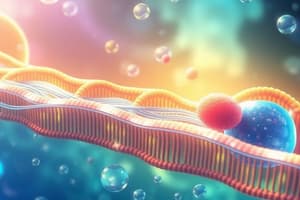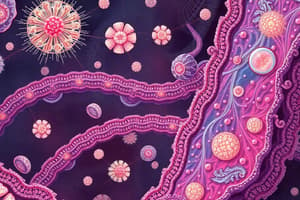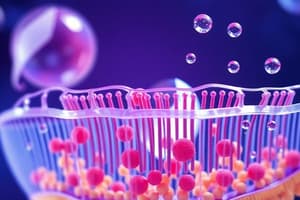Podcast
Questions and Answers
What occurs to an animal cell in a hypotonic solution?
What occurs to an animal cell in a hypotonic solution?
- It becomes rigid and stable.
- It remains unchanged in size.
- It swells and may burst. (correct)
- It shrinks in size.
Which process requires energy to move materials against the concentration gradient?
Which process requires energy to move materials against the concentration gradient?
- Simple diffusion
- Osmosis
- Facilitated diffusion
- Active transport (correct)
What is osmotic pressure primarily driven by?
What is osmotic pressure primarily driven by?
- Membrane permeability factors
- Cell wall rigidity
- Differences in solute concentration (correct)
- Temperature differences
How do plant cells respond to a hypertonic solution?
How do plant cells respond to a hypertonic solution?
Which of the following is NOT a form of active transport?
Which of the following is NOT a form of active transport?
Flashcards are hidden until you start studying
Study Notes
Osmosis in Cells
- Cell membrane is semi-permeable, meaning it allows some substances to pass through while others cannot
- Osmosis is the movement of water molecules across a semi-permeable membrane
- Driven by differences in solute concentration, the net movement of water out of or into a cell produces a force known as osmotic pressure.
- Isotonic solution: The concentration of solutes is the same inside and outside the cell, resulting in no net movement of water
- Hypertonic solution: The concentration of solutes is higher outside the cell than inside, resulting in water moving out of the cell
- Hypotonic solution: The concentration of solutes is lower outside the cell than inside, resulting in water moving into the cell
- Animal cells may burst in hypotonic situations due to an increase in internal pressure as water moves into the cell
- Plant cells are able to maintain their shape even in a hypotonic environment due to the rigid cell wall
Active Transport
- Requires energy to move substances across the cell membrane, against their concentration gradient, from an area of low to high concentration
- Protein pumps: integral membrane proteins that use energy, usually from ATP, to move molecules across the membrane against their concentration gradient
- Endocytosis: process by which the cell takes in materials by engulfing them in a vesicle
- Exocytosis: process by which the cell releases materials by fusing a vesicle with the cell membrane
Studying That Suits You
Use AI to generate personalized quizzes and flashcards to suit your learning preferences.




